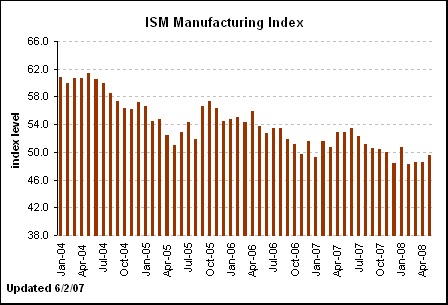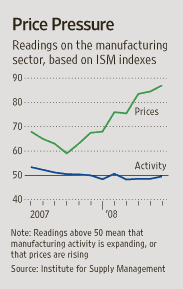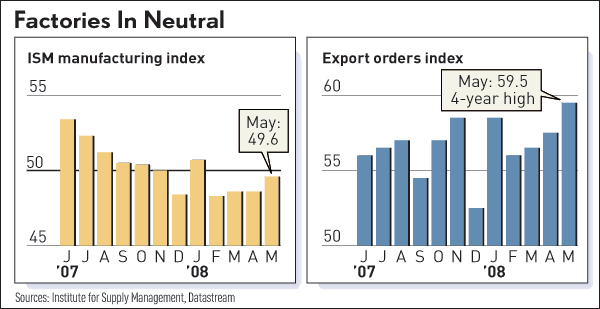U.S. manufacturing activity contracted slightly in May, as exports kept the sector afloat and prices surged, but performed better than many economists had expected.
The Institute for Supply Management said its index of manufacturing activity rose to 49.6 in May from 48.6 in April. It was the fourth consecutive month that the index was below 50; readings below 50 signal a contraction in overall activity.
Even so, the report bolstered other recent data suggesting the economy is stagnant but not collapsing.
A separate report showed construction spending in April dropped by a seasonally adjusted 0.4% from the previous month, to $1.12 billion. Spending on private nonresidential construction, which includes hotels and office buildings, rose 1.6%, partly offsetting the slump in residential construction, which declined 2.3% in April and is down 21% from a year earlier, the Commerce Department said.
In the ISM report, exports continued to increase, extending a five-and-a-half-year trend that is helping offset slowing U.S. demand, and production expanded. New orders rose and imports grew slightly. But high commodity costs pushed prices to a four-year high, and employment and inventories contracted.
"Were it not for the weak dollar," which makes prices of U.S. goods cheaper abroad and stimulates export orders, "I really do believe we'd be looking at far lower readings," said Norbert Ore, a Georgia-Pacific Corp. executive who directs the survey. He noted that 80% of ISM member companies are exporters.
TO place this information in the largest context, go to this article which has a group of charts related to the manufacturing sector.
Let's look at the graphs/charts of these numbers to see what they say:

The general trend since January 2004 is lower. That's the macro-trend that supplies the backdrop. That means the one month increase will have to continue for a few more months before we can say the trend is reversed. Also note this number has been below 50 for four months. That in an of itself is a trend (a negative one) to keep in mind.

As for construction, it has had a negative impact on the economy for the better part of two years now. Notice that the latest numbers -- which show a year over year decline -- are being compared to periods where the number was already negative. That's not good news in the long run.
The fact that most ISM companies are exporters is very eye-opening. It does imply the number is skewed towards positive numbers in the current environment.
Finally -- notice this chart from the WSJ article:

This is the prices part of the ISM report, which has been increasing for some time. That's not good. As the article noted:
Respondents to the ISM survey noted prices are "skyrocketing" and posing "major hurdles." The prices component of the ISM survey jumped to 87 in May from 84.5 in April, and Mr. Ore noted that doesn't yet capture the full impact of rising oil prices.
This chart from the IBD story shows two things. First, it gives us a better read of how the current numbers compare. Secondly, it shows how exports are helping out right now.
